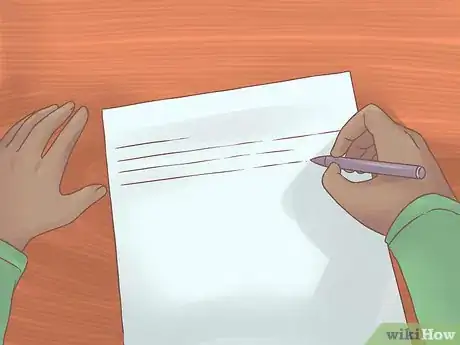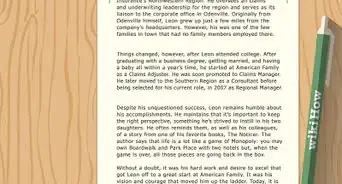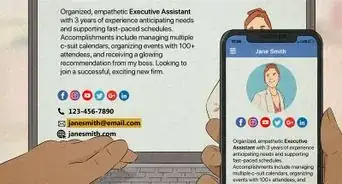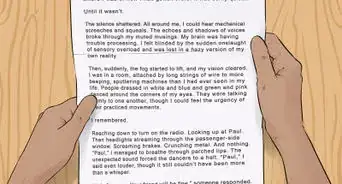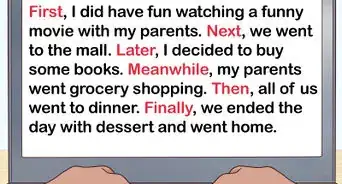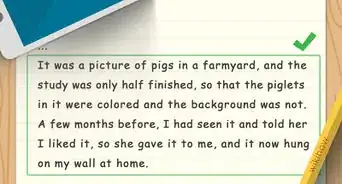This article was co-authored by Dan Klein. Dan Klein is an improvisation expert and coach who teaches at the Stanford University Department of Theater and Performance Studies as well as at Stanford's Graduate School of Business. Dan has been teaching improvisation, creativity, and storytelling to students and organizations around the world for over 20 years. Dan received his BA from Stanford University in 1991.
This article has been viewed 39,959 times.
Writing your life story can seem like a daunting task, especially if you have never told it start to finish before. You may decide to write your life story down on paper to then share with others. Or you may share your story out loud in a performance or a play. Writing your life story effectively takes research, focus, and plotting. Telling your life story may be a good way to work through your past and share life lessons with others.
Steps
Telling Your Life Story Effectively
-
1Do your research. To tell your life story effectively, start by doing your research so you can get the details of the story right. You may interview family members, friends, and other people who were present during certain periods of your life. You can also visit your old childhood home or your former schools as part of your research. Take notes as you do research so you can refer to them when you write your life story.[1]
- You should also do research at your local library and online. You may look at articles and books to help you with your research.
-
2Create a timeline of your life. You may start with your birth and work your way up to the present, noting important events or moments as you go. You may draw a straight line on a piece of paper and fill in the timeline that way. Or you may create a graph on a computer to create the timeline.[2]
- Try to be detailed when you write the timeline. Note each age of your life as well as significant events or moments that happened during that time. For example, you may write, “Age 4, Mom and Dad divorced, I was obsessed with Mickey Mouse and watched a lot of television on our living room floor.”
Advertisement -
3Look for themes in your life story. Another way to make your life story feel meaningful and impactful for a reader is to identify key themes in your life story. You may notice that a specific theme keeps appearing over and over again in key moments in your life. Or you may realize that you worked your way to a certain theme as you got older or aged. You can use the theme to help organize and structure your life story, giving it a deeper meaning.[3]
- For example, you may have the theme “perseverance” in your life story. You may then write about key events or moments in your life that reflect the theme of perseverance.
- Or you may realize that it took you several years to embrace the theme of “hard work.” You may then chart how you learned to embrace this theme through different moments in your life.
-
4Plot out your life story. To give your life story structure, create a plot outline. Having a plot outline can help you stay organized as you write your life story and make your life story engaging for a reader.
- You can create a plot outline based on a more traditional plot structure, with exposition, an inciting incident, rising action, climax, falling action, and resolution.
- You can also use the snowflake method to create a plot outline, with a one sentence summary, a one paragraph summary, character synopses, and a spreadsheet of scenes.
EXPERT TIPDan Klein is an improvisation expert and coach who teaches at the Stanford University Department of Theater and Performance Studies as well as at Stanford's Graduate School of Business. Dan has been teaching improvisation, creativity, and storytelling to students and organizations around the world for over 20 years. Dan received his BA from Stanford University in 1991.Storytelling Teacher
 Dan Klein
Dan Klein
Storytelling TeacherHow did you change through the story? Dan Klein, an improv and storytelling teacher, says: "The essential elements of a story include a character that the audience cares about, and something happening in the story that changes the relationships between the characters. It's also really nice if the story ties up at the end by reincorporating something from the beginning."
-
5Polish the draft. Once you have a draft of your life story, in whatever form it takes, you should polish and edit it until it is at its best. You may show your written life story to others for feedback, such as friends, family, or colleagues. You can also read your life story draft out loud to hear how it sounds on the page.
- If you created a performance based life story, you may perform a rough version for friends, family or colleagues and ask them for feedback. You should revise your draft and improve it until you feel it is ready to share with the larger world.
Writing Your Life Story Down
-
1Put together an autobiography. Perhaps the most popular way of telling a life story is to write your autobiography. An autobiography is a genre of writing where you chronicle your life story. You may start your autobiography from your birth and work your way chronologically through your life story.
- Many autobiographies are written in first person present tense or first person past tense. They usually cover the entire span of a life.
- You can read examples of autobiographies to get a better sense of the genre. For example, you may check to see if your favorite celebrity has an autobiography out or search for an autobiography of a famous historical figure.
-
2Write a memoir. You can also write a memoir as a way to tell your life story. Memoirs are different than autobiographies in that it focuses on particular moments in a life, rather than the entire span of a life. Often, memoirs cover a particular span of a person’s life, such as a dramatic event or a dramatic period.
- You can write the memoir in first person or third person. They are usually written in past tense so you can reflect on a certain time period or event.
- You can read examples of memoir to gain a better understanding of the genre, such as Running with Scissors by Augusten Burroughs, In the Wilderness by Kim Barnes, The Boys of My Youth by Jo Ann Beard, and Angela’s Ashes by Frank McCourt.
-
3Create a long form poem about your life. If you would prefer to write poetry over prose, go for a long form poem that explores your life story. You can write an epic poem, which often spans many pages. Or you may write a series of shorter poems to chronicle your life story. You may use the same poetic form for the poems or play with different poems in each poem.
- Try using the poetic form to reflect a certain period or event in your life story. For example, you may write in a more playful form, such as the limerick, for poems about your childhood. You may then write in the sonnet form to write about a great love of your life.
-
4Write a personal essay. Personal essay is another great way for you to write about your life story. With this form, you can focus on one specific moment, event, or theme that appears in your life story. The personal essay can be a good form to use if you enjoy writing non fiction or a more structured piece on your life story.
- The personal essay contains an introductory section, a body section and a concluding section. You can then play with the form as you see fit and do not need to adhere to a five paragraph essay form.
- You can read examples of the personal essay, such as “Shipping Out” by David Foster Wallace, “The White Album” by Joan Didion, and “We Do Abortions Here” by Sallie Tisdale.
-
5Hire a ghostwriter. Ghostwriters are often hired to help someone write their story, such as their life story. Having a ghostwriter can be a good way to dive into your life story and have someone assist you in shaping your story. The ghostwriter can also help you choose a form for your life story so it is written in a way that is engaging and unique.
- You can search for a ghostwriter online through online writing sites or online classifieds. You can also ask writing professors and other professionals to recommend a ghostwriter.
Sharing Your Life Story Out Loud
-
1Make a spoken word performance. If you would prefer to share your life story in a life, storytelling format, write a spoken word poem. You may create spoken word poems about different periods of your life and then prepare them as a performance for an audience. Or you may create a long spoken word piece that covers key events or moments in your life.
-
2Create a play out of your life story. Another way you can perform your life story for an audience is to create a play based on your life. Perhaps you write a one person show that focuses on stories from your life, which you can then perform on your own. Or maybe you create a play that explores your life with characters from your childhood or adulthood.
- You could then arrange for the play to be performed at your local community center or film yourself performing it and then post it online.
-
3Adapt your life story into a screenplay. You can also share your life story by writing a screenplay based on your life. You may use a key event or moment in your life as inspiration for the screenplay, using characters from your life as the basis for the characters in your screenplay.
- You could then use the screenplay to make a film based on your life. You may rent camera gear, located actors, and shoot the film yourself. Or you may hire a filmmaker to create the film based on your screenplay.
-
4Share your life story in casual conversation. If you are meeting someone new at a social gathering, you may want to share your life story in conversation with them. You should try to make your life story interesting, entertaining, and brief. This way, you can get the details of your life across and keep the conversation going. You may include a few funny details from your life story so the person is engaged in what you have to say.
- For example, you may say, "I was born in Miami, Florida in the 80s, and grew up right by the beach. It was a nice childhood except for that time I got stung by a jellyfish."
References
- ↑ http://createyourlifestory.com/podcast/telling-your-stor/
- ↑ http://www.allprodad.com/10-ways-to-tell-your-life-story/
- ↑ http://www.allprodad.com/10-ways-to-tell-your-life-story/
- ↑ https://www.youtube.com/watch?v=0snNB1yS3IE
- ↑ https://www.youtube.com/watch?v=bGk3-OJX7KE
- ↑ https://www.youtube.com/watch?v=dRl8EIhrQjQ







